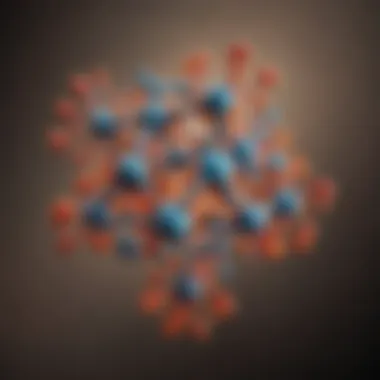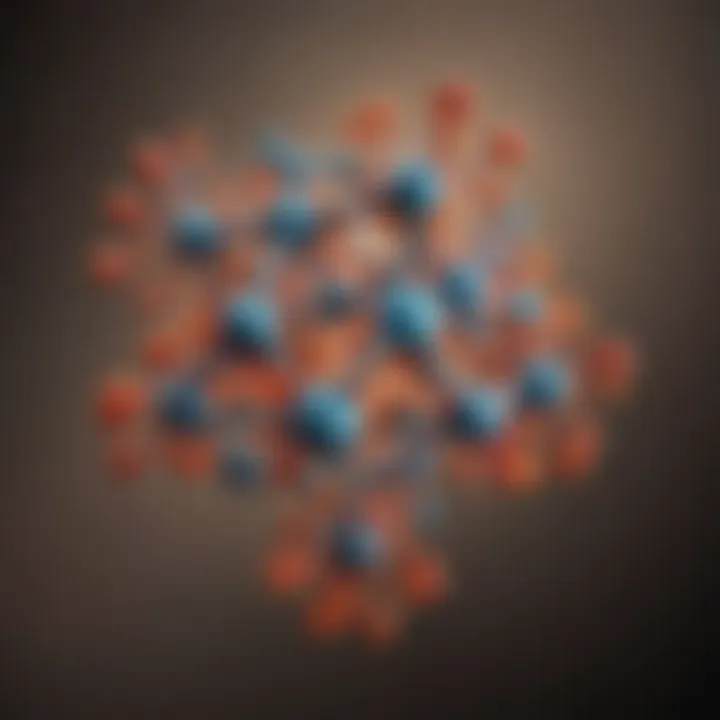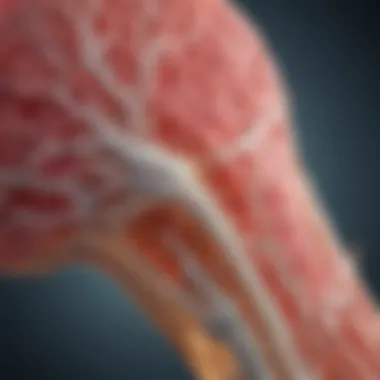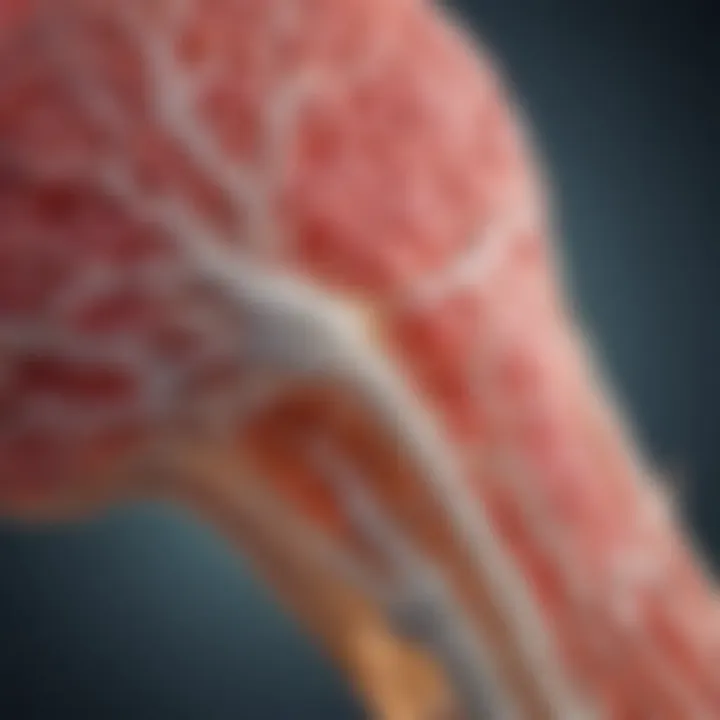A Comprehensive Exploration of Histamine and Its Impacts


Intro
Histamine is a compound that often flies under the radar yet plays significant roles in human physiology. Understanding histamine means delving into its definition, functions, and implications within the body. This article aims to explore these dimensions comprehensively, highlighting not only what histamine is but how it affects health and disease.
Histamine is primarily known for its involvement in allergic reactions, but its functions extend far beyond this. From neurotransmitter release in the brain to regulation of stomach acid, histamine’s operation embodies a fascinating complexity. By dissecting the way histamine works, we can gain insight into various health issues, including allergic responses, digestive disorders, and neurological conditions.
In this exploration, we will engage with topics such as the synthesis of histamine, the mechanisms that prompt its release, and the diverse roles it plays. The relevance of histamine also stretches into the realms of clinical practice, with antihistamines serving as critical tools for managing histamine-related disorders. Through this discourse, we hope to shed light on recent research advancements and the future directions in the field.
Histamine: An Overview
Histamine plays a vital role in numerous physiological processes within the human body. Understanding histamine is crucial for healthcare professionals, researchers, and anyone interested in the biological sciences. This section will elaborate on its definition, the intricacies of its chemical structure, and its historical significance in research. Delving into the world of histamine provides insights into not only its functions but also its implications for health and disease.
Defining Histamine
Histamine is a biogenic amine, primarily recognized for its role as a neurotransmitter and a mediator of allergic responses. It is formed from the decarboxylation of histidine, an amino acid found in many protein-rich foods. When histamine is released, it binds to specific receptors on target cells, inducing various physiological responses. The synthesis and release of histamine can occur in many tissues, but it is most commonly associated with mast cells and basophils.
Histamine is not only a key player in allergic reactions but also has important roles in gastric acid secretion, central nervous system regulation, and immune responses.
Histamine is not only a key player in allergic reactions but also has important roles in gastric acid secretion, central nervous system regulation, and immune responses.
Chemical Structure and Properties
The chemical structure of histamine consists of a two-carbon, imidazole ring with an amine group. This unique formation allows histamine to interact with multiple types of receptors, mainly , , , and . Each receptor mediates different biological effects.
- ** receptors:** Associated with allergic reactions, vasodilation, and increased vascular permeability.
- ** receptors:** Primarily found in the stomach, these receptors regulate gastric acid secretion.
- ** receptors:** Influence neurotransmitter release and modulate central nervous system functions.
- ** receptors:** Involved in inflammatory responses.
Histamine's properties also include its solubility in water and stability under certain conditions. Importantly, histamine can act both locally and systemically within the body, reflecting its varied roles in biology.
Historical Context of Histamine Research
The discovery of histamine dates back to the early 20th century. In 1910, a researcher named Sir Henry Dale first isolated this compound from animal tissues. Over the decades, histamine became a central focus for understanding allergic responses and gastric function. Significant milestones include the identification of its receptors and the development of antihistamines in the 20th century, which changed treatment paradigms for allergies and gastric disorders. Research continues to evolve, exploring histamine's roles in modern medicine, notably concerning its impact on immune responses and migraines.
The knowledge gained over the years emphasizes histamine's complexity and its importance as a subject of ongoing research, with potential implications for various fields in health care.
Synthesis and Release of Histamine
Understanding the synthesis and release of histamine is crucial for grasping its role in various biological processes. Histamine is not simply present in the body; it is generated and released in response to specific physiological needs. This chain of events is important as it provides insight into how histamine functions in health and disease. One must also consider the biochemical and cellular mechanisms that guide these processes. Having a clear understanding of these elements informs the approach taken towards histamine-related disorders and the development of treatment options.
Biochemical Pathways of Histamine Formation
Histamine is synthesized primarily from the amino acid histidine through a decarboxylation reaction. This is facilitated by the enzyme histidine decarboxylase. The reaction removes a carboxyl group, leaving behind histamine as a product. There are several important considerations concerning histamine synthesis:
- The availability of histidine is the first limiting factor. Without sufficient levels of this amino acid in the diet, histamine synthesis cannot occur effectively.
- Additionally, various cofactors, such as pyridoxal phosphate, are required for the proper functioning of histidine decarboxylase.
- The synthesis process is regulated by cellular events, meaning that various stimuli can influence histamine production, which can lead to fluctuations in histamine levels in the body depending on physiological demands.
Cellular Mechanisms of Histamine Release
Histamine release is a complex process that occurs mainly in specific immune cells, namely mast cells and basophils. Various factors can trigger this release, which is critical for physiological responses like inflammation and allergic reactions.
Mast Cells
Mast cells are one of the primary cells responsible for histamine release in the body. They are found in various tissues including connective tissues throughout the skin and mucosal surfaces. When activated, mast cells release histamine into the surrounding area, which facilitates several responses. Their key characteristic is the ability to release numerous mediators, not only histamine, which can amplify an immune response.
Mast cells are particularly relevant for this article because of their extensive role in allergic reactions. However, their benefit comes with some disadvantages. Excessive mast cell activity can lead to hyperreactivity, contributing to allergic disorders. Additionally, the regulation of mast cell activity remains a challenging area in therapeutic contexts.
Basophils
Basophils are another important cell type involved in histamine release. Though they make up a small percentage of the white blood cells, their role in the immune response is significant. Basophils are similar to mast cells in that they also release histamine upon activation but are less abundant and found primarily in the blood.


Their key characteristic is their rapid response to allergens, enabling immediate hypersensitivity reactions. In this article, basophils are considered integral to the discussion on histamine due to their unique properties in coordinating allergic responses. However, as with mast cells, basophils can contribute to adverse reactions if their activation is not correctly regulated.
Other Cell Types
Beyond mast cells and basophils, histamine is released from other cell types, including platelets and certain neurons. This diversifies the biological roles that histamine plays in the body. A notable feature of these other cell types is their varying mechanisms for histamine release.
Platelets release histamine during coagulation, linking it to vascular responses. Neuronal release of histamine is essential in neurotransmission and logistical processes in the brain. Discussing these cell types emphasizes the multifaceted nature of histamine and its broad reach across different physiological systems. The advantage of understanding histamine sources enables researchers and clinicians to tailor interventions based on specific dysfunctions. However, the diverse origins of histamine can complicate diagnoses and treatment plans.
Physiological Functions of Histamine
Histamine is not merely a compound involved in allergic responses; it functions as a key player in various physiological processes. Its roles extend far beyond mere reactionary mechanisms. By examining these diverse functions, we can appreciate the complexity of histamine in maintaining homeostasis and contributing to overall health. The exploration of histamine's physiological functions sheds light on its intricate impact on the human body and emphasizes its relevance in both normal physiological processes and pathological conditions.
Role in Immune Response
Histamine is integral to the immune response. It acts as a signaling molecule, informing the body of potential threats, such as pathogens or allergens. When an allergen is detected, mast cells and basophils release histamine. This release causes various physiological changes. These changes include dilation of blood vessels, increased permeability, and recruitment of immune cells to the site of exposure.
The dilation of blood vessels allows more blood to flow to affected areas, delivering essential immune cells and nutrients. The increased vascular permeability facilitates the movement of immune cells through blood vessel walls, enhancing the speed of the immune response. Thus, histamine’s role orchestrates a rapid, localized response that is crucial for pathogen clearance.
Histamine's swift action during immune responses illustrates its essential function in defending against infections and other harmful agents.
Histamine's swift action during immune responses illustrates its essential function in defending against infections and other harmful agents.
Influence on Neurological Activities
Histamine also plays a significant role in the central nervous system. It acts as a neurotransmitter, influencing various neural functions. Histamine is involved in modulating wakefulness, attention, and learning processes. Certain neurons in the brain release histamine, which then binds to its receptors, affecting neuronal excitability and synaptic transmission. This mechanism promotes alertness and cognitive function.
In addition, histamine is part of the regulation of circadian rhythms, contributing to sleep-wake cycles. Its function as a neurotransmitter demonstrates how histamine also impacts emotional responses and behavioral patterns, linking its physiological roles to neurological health and function.
Vascular Effects of Histamine
Histamine’s vascular effects are noteworthy. It induces vasodilation, which is the widening of blood vessels. This action decreases vascular resistance, promoting increased blood flow to tissues. Histamine achieves this by acting on and receptors on vascular smooth muscle cells, inciting relaxation.
Moreover, histamine contributes to the regulation of blood pressure. During an allergic reaction, the release of histamine can lead to significant blood vessel dilation, resulting in lower blood pressure. This phenomenon underscores the dual role of histamine as both a necessary component of the immune response and a potential contributor to pathological states, such as hypotension during severe allergic reactions.
Gastrointestinal Functionality
In the gastrointestinal tract, histamine plays crucial roles in digestion and gastric secretion. Histamine is released by enterochromaffin-like cells found in the stomach. It stimulates gastric acid secretion by acting on receptors present in gastric parietal cells. This secretion is vital for the digestion of food, aiding in nutrient absorption.
Histamine also facilitates gut motility and functions as a signaling molecule in enteroendocrine cells. This interplay highlights how histamine is essential for maintaining digestive health. Disruptions in histamine signaling can lead to gastrointestinal disorders, attesting to its importance in this system.
Histamine and Allergic Reactions
Histamine plays a pivotal role in allergic reactions, making this topic crucial for understanding histamine’s overall impact on health. Allergic reactions occur when the immune system responds to typically harmless substances, known as allergens. Histamine is released during these reactions, leading to various physiological symptoms. Understanding how histamine works in this context can help clarify its importance and implications for both allergies and related disorders.
Mechanisms of Allergic Response
The mechanisms behind allergic responses involve several steps. When an individual encounters an allergen, their immune system may identify it as a threat. This activates a cascade of events:
- Sensitization Phase: Upon first exposure to an allergen, B cells produce IgE antibodies. These antibodies attach to mast cells and basophils, priming them for the next exposure.
- Subsequent Exposure: On later encounters with the same allergen, the allergen binds to the IgE on mast cells, triggering their activation.
- Release of Histamine: Once activated, mast cells and basophils release histamine into the surrounding tissue.
- Manifestation of Symptoms: The release of histamine leads to vasodilation, increased permeability of blood vessels, and stimulation of sensory nerves, resulting in symptoms like itching, swelling, and redness.
This systematic release of histamine constitutes a key facet of the allergic response, intensifying the reaction triggered by the allergen.
Common Allergens and Histamine Release
Various substances can prompt histamine release through allergic mechanisms. Common allergens include:
- Pollen: Often responsible for seasonal allergies, its interaction with IgE can produce symptoms like hay fever.
- Food Items: Certain foods like nuts, shellfish, and dairy can elicit severe allergic reactions known as food allergies.
- Animal Dander: Proteins found in the skin flakes, urine, and saliva of pets can provoke allergic responses in sensitive individuals.
- Mold Spores: Fungal allergens can trigger reactions, especially in damp environments.


Continuous exposure to these allergens can result in chronic conditions, which may be intertwined with histamine dysregulation.
Continuous exposure to these allergens can result in chronic conditions, which may be intertwined with histamine dysregulation.
Histamine release in response to these allergens can also vary in intensity among individuals. The understanding of these interactions is essential for developing strategies to manage allergies and mitigate symptoms, especially in those prone to severe reactions.
Histamine-Related Disorders
Histamine-related disorders are critical to understand because they reveal the diverse and often adverse effects of histamine in the human body. These disorders can significantly impact the quality of life for those affected. Understanding these conditions helps in formulating effective treatment strategies and improving patient management. This section will delve into histamine intolerance, mast cell activation disorder, and the role of histamine in migraines.
Histamine Intolerance
Histamine intolerance occurs when there is an imbalance between histamine intake and the body's ability to break it down. This imbalance can lead to various symptoms that often overlap with other conditions, making it challenging to diagnose. It is crucial to recognize this condition as it can help alleviate discomfort by pinpointing dietary triggers and managing symptoms effectively.
Symptoms
Symptoms of histamine intolerance can vary widely but generally include headaches, hives, digestive issues, and nasal congestion. The key characteristic of these symptoms is their onset after the consumption of histamine-rich foods. This aspect is beneficial for the article since it emphasizes how individuals can identify and adjust their diets to mitigate reactions. A unique feature of these symptoms is their non-specific nature; they can mimic other allergic responses or even gastrointestinal disorders, making awareness essential for both patients and healthcare providers.
Diagnosis
Diagnosing histamine intolerance is often involves an elimination diet followed by a food challenge. This diagnostic method is beneficial for this article because it underscores the practical steps individuals can take to determine their condition. However, the unique feature of this diagnostic approach is its reliance on patient observation and subjective reporting, which can introduce variability and challenge the accuracy of the diagnosis. Therefore, a detailed history of symptoms and food intake is crucial.
Management
Management of histamine intolerance primarily involves dietary changes. Identifying and eliminating histamine-rich foods can significantly improve symptoms. This approach is beneficial for the article as it offers practical solutions to readers who may be searching for ways to improve their health. A unique feature of this management strategy is the potential for individual variability; some individuals may tolerate certain foods better than others. Understanding personal triggers can lead to a more tailored and effective management plan.
Mast Cell Activation Disorder
Mast cell activation disorder (MCAD) denotes a group of conditions characterized by the inappropriate activation of mast cells. These cells release histamine and other mediators that can result in allergic symptoms even in the absence of allergens. The significance of MCAD lies in its complexity and the broad spectrum of symptoms it can induce, which may include skin rashes, abdominal pain, and cardiovascular issues. Given its implications for histamine research, understanding MCAD is essential for developing targeted therapeutic approaches.
Role of Histamine in Migraines
Histamine is increasingly recognized as a significant factor in migraine pathology. It affects vascular dynamics and could play a central role in the onset of migraine attacks. Insights into this relationship foster a greater comprehension of migraines and similar disorders. By focusing on histamine's role in migraines, the article can highlight potential treatment avenues, particularly those targeting histamine pathways.
In summary, histamine-related disorders provide a compelling insight into the multifaceted roles of histamine in health and disease. Understanding these disorders can lead to better management strategies and further research opportunities.
Antihistamines: Mechanisms and Applications
Antihistamines play a crucial role in managing the effects of histamine in the human body, especially concerning allergic reactions and various disorders. Understanding how these medications work provides insights into their importance in therapeutic settings. The discussion of antihistamines particularly emphasizes their classification into first-generation and second-generation types, their mechanisms of action, and their clinical applications.
Types of Antihistamines
First-Generation
First-generation antihistamines are known for their sedative effects and ability to rapidly cross the blood-brain barrier. This characteristic leads to a considerable reduction in allergic symptoms, but also causes drowsiness. Medications like diphenhydramine and chlorpheniramine fall into this category. They are often a popular choice for many due to their efficacy in treating both allergic conditions and more severe reactions, like anaphylaxis, when used as part of a broader treatment protocol. However, their sedative effects limit their use in situations requiring alertness, like driving.
Key aspects of first-generation antihistamines include:
- Sedation: Many patients may find it beneficial for nighttime allergy relief.
- Quick onset: These medications typically provide rapid relief from symptoms.
- Use in combination therapies: They are often combined with other drugs for conditions such as colds or insomnia.
Their unique feature, causing drowsiness, is also seen as a disadvantage, making them less suitable for daily use in non-drowsy-required environments.
Second-Generation
Second-generation antihistamines, such as cetirizine and loratadine, present a significant advancement in allergy treatment. These medications are designed to minimize sedation while still effectively reducing histaminic symptoms. The primary advantage is their low effect on the central nervous system, allowing users to maintain normal daily activities without drowsiness.
Characteristics of second-generation antihistamines include:


- Non-sedative: These are preferred for day-time use due to reduced sedation.
- Longer duration of action: Patients often only need to take them once daily.
- Lower risk of side effects: Compared to first-generation, they tend to be better tolerated.
Their unique feature of decreased sedation represents a significant improvement for patients looking for continuous relief without the impairment of alertness.
Mechanisms of Action
The mechanism of action for antihistamines centers on their ability to block the receptor, thus impeding the physiological effects of histamine. This blocking action reduces symptoms such as itching, swelling, and vasodilation associated with allergic reactions. By preventing histamine from binding to these receptors, antihistamines contribute significantly to symptom control in allergy sufferers.
Clinical Applications and Efficacy
Antihistamines are primarily prescribed for disorders like allergic rhinitis, urticaria, and some types of eczema. Their efficacy is well-documented, making them a first-line treatment option in many allergic conditions. The choice between first and second-generation antihistamines often depends on the specific patient needs, including desired effects and potential side effects.
As a conclusion, antihistamines are an essential part of managing histamine-related disorders. By understanding their types, mechanisms, and applications, patients and healthcare professionals can make informed decisions about their use in clinical practice.
Recent Research and Future Directions
The exploration of histamine and its functions is shaping new paradigms in medical research. Recent studies reveal a deepening understanding of histamine's role beyond traditional views, particularly in immunology and neurobiology. Research into the effects of histamine on various physiological systems promotes a more holistic view of its contributions to health and disease. Focusing on recent advancements can provide insights into potential applications that go beyond antihistamines and allergy management. These advancements pave the way for novel therapeutic strategies and deepen our understanding of histamine-related disorders.
Advancements in Histamine Research
Recent studies have provided significant advancements in comprehending histamine's role in the body. Scholars have increasingly focused on the complex interactions within various cell types. This includes exploring histamine's role in autoimmune diseases and its potential neuroprotective functions. Key findings point to a multifaceted involvement in conditions such as multiple sclerosis and rheumatoid arthritis. Also, advances in imaging technologies have enhanced our understanding of histamine's dynamic actions in live tissues.
Several noteworthy developments include:
- Histamine's Role in Neuronal Communication: Studies indicate it may facilitate neurotransmission in the brain.
- Identification of Receptor Subtypes: New receptor subtypes have been discovered, which opens pathways for targeted therapies.
- Biomarkers for Histamine-Related Disorders: Researchers are identifying specific biomarkers that could lead to better diagnostics.
Potential Therapeutic Approaches
The potential therapeutic approaches stemming from recent histamine research are diverse. Researchers are exploring histamine receptor antagonists as treatments for a range of conditions, including mental health disorders. The implications of histamine in inflammation have prompted investigations into novel anti-inflammatory agents that could modulate histamine's actions without traditional side effects experienced with current antihistamines.
Some promising areas of focus include:
- Targeted Antagonists: Specific antagonists targeting unique histamine receptors involved in particular diseases.
- Histamine-Related Immunotherapy: Utilizing histamine's modulation of immune responses for therapeutic benefits.
- Neuroprotective Drugs: Investigating drugs that could enhance histamine’s neuroprotective effects without compromising its other functions.
Challenges and Controversies
Despite promising advancements, challenges remain in histamine research. One significant concern is the complexity of histamine pathways. Understanding these requires interdisciplinary approaches that can integrate findings from fields like immunology, neurology, and pharmacology.
Notable controversies include:
- Debate Over Histamine’s Role: Ongoing discussions question whether it contributes positively or negatively in various contexts.
- Side Effects of Antihistamines: There is an ongoing discourse about the long-term impacts of first-generation antihistamines, potentially complicating treatment options.
- Research Funding Limits: Funding for histamine research often does not match the urgency needed for its potential impact on public health.
The convergence of advances and challenges forms a complex narrative around histamine research. Continued efforts are necessary to unlock its potential. The interplay of this research with clinical applications holds promise for improved health outcomes.
Finale
In this article, the conclusion serves as a crucial component of understanding histamine's complex roles in the human body. It summarizes the key aspects discussed throughout the text and highlights the implications of histamine on health and disease.
By reflecting on the synthesis, release, and physiological functions of histamine, one recognizes its rapid involvement in immune responses, allergenic activity, and the regulation of various bodily functions like digestion and neurotransmission. These aspects underline histamine's significance, demonstrating how it operates not just as an inflammatory mediator but as a multifaceted participant in cellular communication and homeostasis.
Moreover, the challenges posed by histamine-related disorders, including histamine intolerance and mast cell activation, encourage further research. Through a thorough examination of both antihistamines and emerging treatments, professionals in the field can find pathways to improve patient care.
Recognizing the complexities of histamine interactions within biological systems highlights the need for ongoing investigation. It emphasizes how important it is for healthcare practitioners, researchers, and students to keep abreast of new findings, particularly as they relate to the treatment of allergies and other related conditions. Thus, the conclusion consolidates the informative nature of this article while also beckoning further exploration into this critical area of study.
Summary of Key Points
- Definition and Functions: Histamine, a biologically active compound, plays vital roles in various physiological processes, including immune response and neurotransmission.
- Synthesis and Release Mechanisms: Understanding the biochemical pathways and cellular mechanisms involved in histamine production helps clarify its function in health and disease.
- Histamine's Role in Disorders: Various histamine-related disorders, such as histamine intolerance and mast cell activation disorders, require careful consideration and management.
- Antihistamines and Clinical Applications: The article explores the types of antihistamines and their mechanisms of action, showcasing their relevance in clinical practice and patient health.
- Future Research Directions: Emerging therapeutic approaches and the need for more definitive studies are imperative for enhancing understanding and treatment of histamine-related conditions.
Implications for Further Study
The study of histamine presents numerous opportunities for further investigation. Scientists and healthcare professionals should focus on:
- Expanding Research on Histamine Functions: More studies are needed to explore lesser-known functions of histamine and its signaling pathways.
- Investigating Histamine-Related Disorders: As the population grows more aware of histamine intolerance, research into its underlying mechanisms becomes crucial.
- Development of New Therapeutic Options: Exploring novel antihistamines and alternative treatments may lead to improved efficacy and fewer side effects.
- Interdisciplinary Approaches: Collaboration between immunologists, neurologists, and gastroenterologists could yield a more comprehensive understanding of histamine's impacts across systems.



